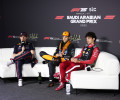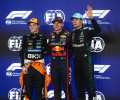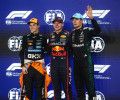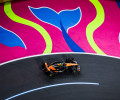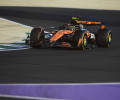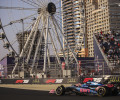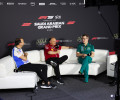2013 Spanish Grand Prix - Friday Press Conference
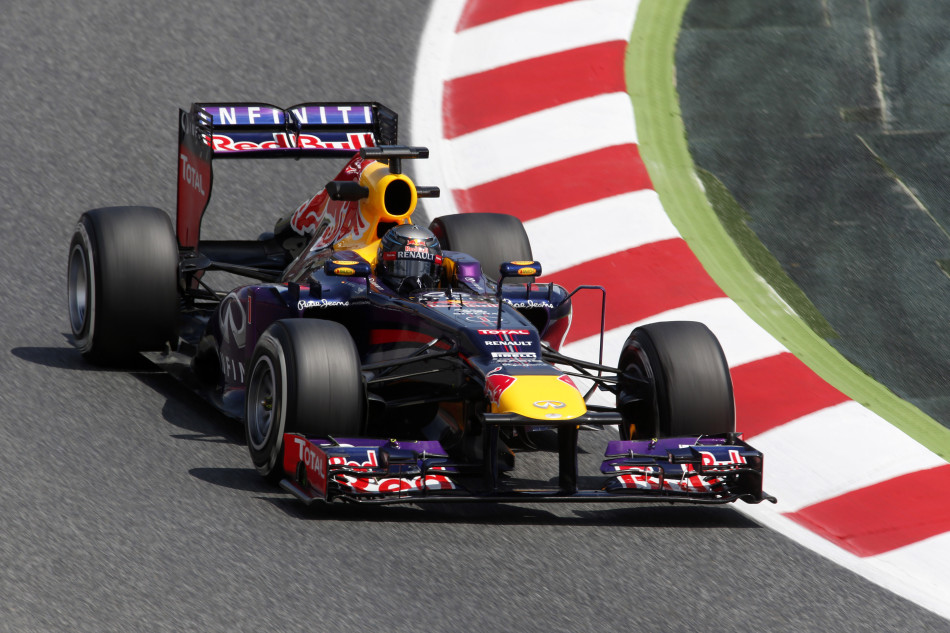
TEAM REPRESENTATIVES – Dave GREENWOOD (Marussia), Mike COUGHLAN (Williams), Mark SMITH (Caterham), Andrew GREEN (Force India), Nikolas TOMBAZIS (Ferrari), Adrian NEWEY (Red Bull Racing)
PRESS CONFERENCE
Mike Coughlan, if we can start with you. You won here last year but what conclusions are we to draw from your performances so far this season?
Mike COUGHLAN: Well, we’re disappointed. It’s a fast-moving sport, everybody’s progressing and we haven’t made enough progress. We’re making steps in the right direction. We’re making steps in the right direction but there’s a long way… there’s at least a second to catch up.
And what did you learn from today?
MC: We learned that the prototype tyres didn’t work on our car and we found that… we had an aero test last week, some things we learned have worked on the circuit here, but we’ve still got a lot of work to do.
Thanks very much. If we can move to Nikolas Tombazis. Obviously, a lot of discussions at the moment about the re-introduction of testing in Formula One. The vote this week didn’t necessarily go in favour of it, but do you feel that’s the end of the story or do you think there is a chance that will be revisited?
Nikolas TOMBAZIS: To be honest I think it’s something more for the team principals to be discussing with each other. I guess there will be more discussion about it but I don’t think it will be at our level of engineer to be honest that we discuss it.
And today? Obviously very close between yourselves and Red Bull. What conclusions do you draw from the running we saw this afternoon?
NT: I think it’s very difficult to draw any conclusions properly from a Friday. I think we are in reasonable shape but it’s impossible to know exactly what fuel levels each team is running. So, I think we’re cautiously optimistic but I couldn’t say more than that. In the morning obviously it was raining so it was not easy to test some of the components we were planning to test. So that’s an ongoing process that will go on for the next race to try and establish whether the new bits are actually faster or not, so it’s not possible to answer all the questions in one single session.
Obviously your old colleague James Allison is back on the market, do you fancy a reunion with him in Maranello?
NT: I’m very good friends with James, I think he’s a super bloke both technically and ‘humanly’. I think that any team having him would be making a good buy. Whether he is coming to us or not is a story to ask the team principals.
Okay, thank you for that. Adrian, your thoughts on today? Obviously, you and Ferrari look very quick but as Nik was saying it’s not always easy to draw conclusions from Friday. However, do you see it being a scrap between the two of you this weekend?
Adrian NEWEY: Well, If Nik would be kind us enough to tell us what his fuel load was this afternoon we’d have a better idea, but he probably won’t do that so, no, as Nik says then it’s certainly tight with Ferrari. Lotus I’m sure will be good, we’ve seen they have very good tyre degradation, and Mercedes are the outsiders I guess, so it’s the usual story of the last few races.
Obviously Red Bull was one of the teams calling for a change to the tyre specifications. Pirelli has made one change, to the hard tyre that we have here this weekend. That was the preferred tyre here in the race last season. Can you give us your take on the changes that have been made? Did it go far enough as far as you’re concerned?
AN: The changes to the tyre relative to last year are two-fold, one has been construction and the other has been compound. As you say they’ve gone back to the compound that we used in some of the races last year but that still leaves a very significant construction change, so it’s still a very different tyre to what we had last year.
Moving on to Dave Greenwood from Marussia. Obviously Marussia have taken a clear step forward this year in performance. Can you quantify it for us and tell us where the major gains have come from?
Dave GREENWOOD: Well, it’s difficult to put exact numbers on it but definitely we’re a per cent or so closer to the front. We no longer worry about anything like 107 per cent, those days are long gone, so it’s much more looking towards the midfield, where we want to go. Obviously, as anyone else would say, the main advantage has come in aerodynamics – better correlation in the wind tunnel – and perhaps slightly more creativity in that area. That’s where really most of the lap time has come, coupled with improvements in the mechanical installation of course.
We spoke earlier about the possibility of in-season testing returning. As one of the teams with a smaller budget how would feel about that?
DG: It’s a tricky one isn’t it? As an engineer you’d want to go testing but obviously there’s a resource issue there to consider as well. I think as Nikolas said, it’s probably one more for the team principals. But I think for us it would be as long as it was in a measured, controlled way and not an absolute free-for-all then maybe it would be something that would enable us to slightly catch up by having a little bit more testing.
Moving on to Andrew. Obviously, first of all, we have to start by asking about Paul Di Resta’s left-rear tyre failure. What can you tell us about that from second practice this afternoon?
Andrew GREEN: Well, completely unexpected, in the middle of a high-fuel run, it was on about lap six or seven. That’s all we know at the moment. It’s currently under investigation by Pirelli and I’m sure they’ll release something as soon as they know but it’s early days yet.
What’s the protocol when something like this happens, in terms of how you as a team interact with them, in terms of moving forward from here?
AG: We’re completely with them. We’ll give them everything they need to understand what happened with the tyres. It’s one of the reasons why we stopped the car straight away – to not damage the tyre and give them as big an opportunity as possible to understand what happened.
Obviously it’s been a competitive start to the season fro Force India; you’re beating teams with larger budgets. How is that done?
AG: How’s it done?
Yes.
AG: We’ve got our own programme. We’ve been on a stepped improvement every year for the last three or four years. We do our own thing. We try to understand the car as much as we can and move forward in areas where we see the performance gains. We are massively resource limited in our team. We haven’t got the big budgets, we’ve got to pick and choose where we develop the car and make sure we develop it in areas that give good rewards and we’ll continue to do that. One of the key things for this year, which we identified last year was race performance on Sunday, tyres life. Understanding the tyres was a big part of this car and has given us a big opportunity to set the car up for all different conditions, all different tyre types. So that’s helped us on the Sunday for sure. But it’s everywhere; it’s a little bit of everything. The wind tunnel guys are busy trying to add performance from their side, and on the tyre side we’re trying to manage the tyres mechanically.
Moving on to Mark Smith from Caterham. We’ve seen in the past Caterham talking a lot about upgrade packages when they come along, but there seems to have been hardly any talk about this one at all. Can you tell us what you’ve done and why you’ve decided to keep quiet about it this time?
Mark SMITH: The strategy that we had, for a number of reasons, was to introduce a car for the first four races that was probably 30 per cent of what would ordinarily be the new season’s car. So, yes, it’s an upgrade but in actual fact it takes us to the point that ordinarily this would have been our roll-out car. And that has to do with understanding the way we model things and not committing to things. We felt that had we have done the car in the normal timescale we would have been taking parts to production and to the car that we weren’t particularly ready with in terms of our understanding and modeling and so on. So it’s more a case that this is the new car.
Can you tell us what the impact the return of Heikki Kovalainen in a development role has had on you in the past month or so?
MS: It has been very useful. Obviously, Heikki worked with the team previously. We lost driver continuity. So that in itself, when Heikki ran in FP1 in Bahrain, was a positive. There were some minor set-up directions that we were considering and in fact Heikki endorse those independently, so that was useful. So in terms of having some continuity, having some connection to the previous car, which actually the car he drove in Bahrain was only a minor development of, has been useful.
QUESTIONS FROM THE FLOOR
Q: (Dan Knutson – Auto Action and National Speedsport News) All of you have upgrades here; could you tell us what the new parts are on your car and please be specific?
MC: New front wing, some forward floor changes, but that’s it.
DG: New front wing, new floor, new suspension parts on the front suspension, so not just aerodynamic. Reasonably comprehensive I would say.
MS: Front and rear wing, floor, some bodywork parts.
NT: Sorry, but I think I will be a spoilsport and won’t specify. You can look at the photos.
AN: I think it’s a bit of an unreasonable question really. It’s all part of the sport isn’t it, to find out what we’ve done?
Q: But presumably there have been plenty of boxes arriving overnight from England.
AN: Well, we’ve got to keep the boys in sandwiches.
AG: Bit of everything, really: aerodynamic and mechanical.
Q: Is it as significant an update package here at Barcelona as it has been in the past?
Is it one of the most important milestones?
AG: Not as big as it has been, but it’s still significant, yeah.
Q: (Paolo Ianieri – La Gazzetta dello Sport) Tombazis, the upgrades that you brought here, are they working reasonably well and do you think they are going to help you to try to catch pole position tomorrow?
NT: As I said before, because it was raining in the morning, we haven’t had the opportunity to do all the back to backs as we would have liked. It’s quite difficult to get good answers on a Friday even if it’s not raining because of the tyres and the various other things one has to do on a Friday. So we were are still analysing and it’s an on-going process. I would say that some things are working, some things are not but we will have to also re-test some things at the next race, before we decide properly.
Q: Fernando was saying that qualifying pace was something that he wanted more of from the Ferrari. Did you set that as a first order priority for this upgrade?
NT: Yes, I think it’s quite clear we want to improve there, but obviously if we improve there we don’t want to give away some of our race pace so the race pace is still more important in some ways for the end result but sometimes when we start further back it makes things a lot more difficult, so yes, qualifying is a priority.
Q: (Mike Doodson – Auto Action) From time to time, the idea of having a point for pole position comes up. I understand the idea has been discussed recently and rejected. Without putting all of you to any trouble, could I ask perhaps Nick and Adrian if they are first in favour of that or why was the idea rejected?
AN: To be perfectly honest, I wasn’t aware that it had been discussed again lately. Certainly, when I was in IndyCars, and that was the standard procedure it always seemed to me to be a good thing. It gives a little bit more emphasis to qualifying, bit more to the show if you like and qualifying’s all part of the TV spectacle. It seemed like a little extra bonus at the end and seemed sensible. That’s my personal opinion.
NT: Yeah, I must say that I don’t think it’s a bad idea provided it’s clear from the start what the rule is then one can make one’s assessment between performances in qualifying and the race. I’m not against it, personally. I also wasn’t aware of it being discussed. It’s possibly a good thing.
Q: (Alex Oller – Associated Press) Mr Coughlan, regarding Pastor Maldonado’s struggles this season: do you think you might be pressing a little bit, due to a lack of confidence in the car and also, might there be an adjustment due to the change with the personal engineer?
MC: No, I don’t think so. It’s a fast-moving sport, there’s lots of little things. This time last year we had a good balance here and the driver was very confident on the Saturday but not so good on the Friday, so there’s a lot of work to do. We have a good team, Pastor’s very focused, working hard. It’s just going to come down to hard work and small steps.
Q: (Sam Collins – RaceCar Engineering) Looking at this car and next year’s car, some of you guys have got a bit of a challenge of resources, some from the RRA and some from your own team’s resources. At what point are you going to switch off development of the 2013 car and switch on to the 2014 fully, and what’s going to be the thing that makes that decision happen?
MS: I don’t know that there will be an absolute switch off. I think these things... obviously 2014 represents a big change so in terms of resource, everybody’s resource-limited, you’re just given the level that you work at, so to a greater or lesser extent, I think every team will have been looking at 2014 for a while now. The time at which you switch the majority of resources will be different for all teams because all teams will be facing different challenges in the championship. For us, 2014 is a very significant thing and I suspect that the majority of our resources will have moved over after Barcelona.
DG: Well, in terms of resources, yeah, obviously we are one of the resource-limited teams but that’s not to say we don’t have big ambitions for 2014, so we’ve done quite a big change-over to that already, in terms of specifics of wind tunnel times, detailing and even design time, there’s a lot going on for 2014 already. It’s a tricky one because we still keep where we are in 2013 with one eye on it, more from the point of view of ensuring that if the opportunities are there to move up, then we’ve still got to keep a development going, so probably similar to what Mark says, it’s about that point now where it’s all or nothing basically.
AN: It’s a hugely difficult problem. In an ideal world, you kind of try briefly to increase your work force to deal with the resources needed for this and then shrink back down but that’s neither feasible not practical really. I think that certainly for us, we have to put effort into the ’14 car, we can’t just ignore it. We are putting effort into it at the moment. This is actually about how that percentage varies throughout the year. Well, to some extent it depends on how our championship programme is.. Clearly, if you’re in a tight battle for a championship, you don’t want to turn your back on that. Equally... it’s a juggling act, there’s no magic formula to it.
Q: (Matt Youson – RaceTech) Nick, how does the 2014 power unit dictate the aero of next year’s car?
NT: It’s a hugely complicated project from a mechanical point of view, the installation of the turbo with all the energy recovery and the completely different looms and also all the other issues my colleagues spoke about - in terms of resource allocation make it very difficult to focus on this project as much as one would like. So one of the challenges is to make sure that apart from the work that the engine people need to do to make sure that they get the most efficiency/power/fuel efficiency etc, is to also make sure that one doesn’t take any wrong turnings in terms of the packaging of this new power unit into the car. It would be a big shame if one discovers, from the start of the next season, that one has missed some trick and has to live with a sub-optimally packaged power unit. So a lot of the early aerodynamic work has to do with answering basic fundamental questions about that installation and obviously the engine being so different, there’s also a lot of other things that are... one loses points of reference compared to the previous year. For example, the cooling could be one of them, or gearbox or whatever. So there’ s a lot of importance in being good at your simulations at this stage so as to be able to not over-design or under-design some particular aspect.
Q: (Luis Vasconcelos – Formula Press) For all six of you: we’re coming to the end of this set of regulations after five years. For all of you, which was the most satisfying car you had in this period and why, and what was the car which you felt you could have done a better job with, and again, why?
AG: This car is going to be the most satisfying car, to be honest. It’s got all the potential to be and we’re really looking forward to this season. I think there are some really strong races ahead. I would say this car, for sure. And the one we could have done more with? Every other one, for sure.
AN: I think to pick out one car is difficult. I think overall I’ve certainly enjoyed the challenge of the regulation change from 2009. I think we didn’t win the championship in 2009 but in some ways I’m most proud of that, as a team, not me personally, but I think as a team we did a good job with that car. We didn’t have a double diffuser which is still a matter of contention about the legality of that, which is obviously all history and that, without doubt, to some extent, cost us the championship together with the fact that as a team we just weren’t mature enough at the time to know how to operate the car to a championship-winning level really. But I think it’s the catalyst that gave everybody in Milton Keynes the confidence to step forwards and out of the ex-Jaguar ‘always seventh in the championship’ –type position that people felt a bit beaten into and put a spring in their step and launched us into the following cars.
NT: Well, obviously for Ferrari, this set of the regulations, the last five years have been quite difficult. We’ve had some years that we were very disappointed with and I’m hoping that at the end of the season I will say that this year is one that we are most happy with but clearly we have to wait and see for that.
MS: I think for a number of reasons which generally revolve around the way we’re working as a team and the way we are going about our business, I would say that it’s the current car.
MC: Obviously last year’s car returned Williams to winning ways and we perhaps didn’t make as much use of it as we could have done but certainly here last year and that car.
DG: Obviously this year’s car for the reasons we’ve come a long way since we entered in 2010 but I would say this is the biggest step we’ve made year on year and the most significant one.
Q: (Kate Walker – GP Week) We’ve recently had quite a bit of discussion that’s since fallen by the wayside about integrating young driver tests into the race weekend. How do you guys feel about that? Do think it’s good for bringing on talent or are you wary about these young guns damaging your precious new parts?
NT: It’s not exactly the sort of topic I normally think about much. I think the way of testing makes it very difficult for young drivers to really get started so to find a solution to that would be a good idea. Whether that would work at a race weekend I’m not sure, unless it’s the Monday after a race or something like that.
AN: I think the first problem actually comes from the lower formulas inasmuch as we seem to be in a situation where now in GP2, for instance, experience counts hugely and quite often it will be drivers in their third or fourth season that win the championship, which seems to me quite an unhealthy way to be. I think also now, with the way the tyres are behaving, then to have junior formulas where the tyres are lasting three or four laps before they’ve gone off heavily, young drivers need mileage, they need seat time and it concerns me that the way the lower formulae are going they’re just not getting that.
AG: Well, from Force India’s point of view, we’ve got a track record of bringing young drivers through and it’s something that we’re very proud of, something we’d like to have the ability to do more of so we definitely look towards a change in regulations so we can bring young drivers through without compromising the race weekend. We put forward a motion in the meeting yesterday but I’m sure there will be further discussions on it. Hopefully we can come to some agreement because I think it’s probably a little bit short-sighted of the sport not to recognise that these young guys do need time in the car.
Q: Do you have a Friday driver in the pipeline?
AG: Yes, there’s one coming through. Hopefully we will announce something shortly.
DG: This is something we actively participate in, in using young drivers in an FP1 session but I think tyres is key at the moment. Perhaps one set of tyres in FP1 is not quite enough for these guys and maybe we need to look to giving them a few more sets of tyres.
Mike, Williams is another team that has run Friday-morning drivers, you’re not doing it at the moment, are there plans to do that this year?
MC: Not at the moment, no. I think our experience, although it’s improved Valtteri tremendously last year, Bruno [Senna] would argue he probably suffered a little bit from it. So it’s a difficult call. I don’t really have an answer.
…and Mark?
MS: It’s a general philosophy. When we have the opportunity we’ve given young drivers a chance in FP1. It’s not something… going beyond that in the way you describe is not something I’ve given a lot of thought to – but in principle, as Adrian says, there’s a shortfall in terms of opportunity for guys new to Formula One to get to grips with it. So there could be something positive there, yeah.
Q: (Dan Knutson – Auto Action / National Speedsport News) Nik, a question for you: when you’re designing and developing a car, how do you take into account and balance the fact that your drivers might have different driving styles and might want different things from the car?
NT: The differences are not that massive. The both want more downforce and less drag and so on. So the basic parameters are not too different. But they do have some slightly different characteristics: what they feel makes it more difficult under braking for example, or mid-corner or whatever. But we try to establish an average condition so as to have an overall car that’s best – and then what the drivers prefer is dealt with in car setup.
Q: (Ted Kravitz – Sky Sports) Question for Mike: Mike, this is the first year you’ve been back in Formula One full time, even though you did do some races last year, first year I should say since the events of 2007. Has it been like a fresh start with Williams?
MC: I’ve enjoyed it tremendously. I did work all last year doing it too. I’ve enjoyed it. It’s a great engineering challenge. If you’re an engineer, Formula One is a great engineering challenge, so I’ve enjoyed every moment of it. Even though we’re struggling a little bit now, the challenge is to get back.
Q: (Nicolas Carpentier – F1i) Back to 2014. Mark Smith talks about the big change, will these cars look very different from this year’s cars in their shape? I guess you already have an idea: a shorter engine cover or something like that…
DG: The initial rules framing the regulations of where bodywork exists etcetera have been out now and published and a lot of discussions have taken place in the technical working group meetings and I think everyone has now got the confidence to start laying cars out and initial wind tunnel tests and CFD etcetera. The version I’ve seen looks very much like… the cars won’t look immensely different once you get used to them. The first time you see then, you’ll decide they’re a lot different and then by three races in you’ll think they always looked like that. There are some areas that have gone. Like the beam wing, which is probably the most significant but the rest of them, you’ll still think it looks like a current Formula One car.
Adrian, your thoughts.
AN: So much of the shape of the car is dictated by the regulations, and that kind of hems you in. Visually, as was said the lack of the beam wing, the low nose which is again forced by regulations and a slightly narrower overall front wing – 75mm a side narrower. Those are the other things you’ll notice. The other thing, depending on how good a job everybody manages to do, is probably slightly bigger sidepods to accommodate the significantly increased cooling requirements.
Are these regulations that excite you?
AN: They’re different and I think it’s always good to have something different. I think the whole philosophy of the engine and the KERS unit and energy storage is altogether another matter – but that’s more for the engine group.
Q: (Alan Baldwin – Reuters) Mike, talking on the technical side about Williams. Since Mark Gillan left, how much has the team suffered from that and are there any plans for you to bring in another heavy-hitter to help you out and bounce ideas off?
MC: No, I don’t think so. As soon as somebody moves on there’s always somebody younger and fresher who wants to take that place. Obviously change is something we try to avoid – especially with somebody of Mark’s calibre – but at the moment, no, we don’t plan to bring anybody else in.
Ends

 Facebook
Facebook Twitter
Twitter